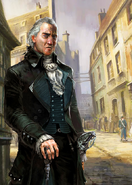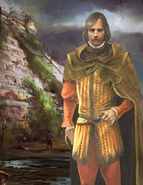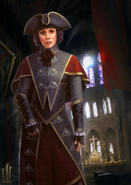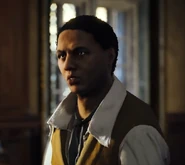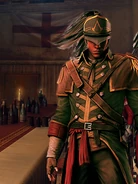| West Indies Rite of the Templar Order | |
|---|---|
 | |
| Organizational information | |
| Founder | |
| Leader's title |
Grand Master |
| Headquarters |
Havana (formerly) |
| Locations |
Caribbean |
| Historical information | |
| Date formed |
Possibly around the early 1700s |
| Date collapsed |
1722 |
| Date reorganized |
1767 |
| Additional information | |
| Notable members |
|
The West Indies Rite of the Templar Order, sometimes known simply as the Caribbean Rite, or the Caribbean Templars, were a group of like-minded individuals who swore fealty to the Templar ideals, and operated in the area during the early and late 18th century, and the beginning of the 19th century.
History[]
Golden Age of Piracy[]
1700s–1722
Led by Laureano de Torres y Ayala, the two-time governor of Havana, Cuba, the rite was a relatively young, yet organized and effective force. Their primary objective was the acquisition of the Sage, from whom they hoped to learn the location of the Observatory. When the Rite failed in 1722, the remaining Templars were hunted down and either killed or turn themselves to the Assassins. However the Blaise-family in New Orleans had other plans.
The Assassins' Golden Age[]
1722–1770
In the late 1750s, the Blaise-family had decided to station several of their agents in the Caribbean. By doing this, the New Orleans Rite managed to get their foothold in the Caribbean once again. In the early 1760s, Quentin and Frédéric Blaise played a vital part in the establishing of the new West Indies Rite. Later, the Master Templar Madeleine de L'Isle sent three Templars to the city of Saint Pierre, Martinique. Here they soon managed to restore the Rite that once had been. But they needed help. Officially, the Grand Master of the new Rite was Marquis de Pimôdan; practically, it was Madeleine de L'Isle that was the Grand Master.
The Purge[]
1770–1776
In 1770, Madeleine agreed with Haytham Kenway to send two of their trained Templar-puppets: Lady Concord and Eric Rackham. They would attack and kill diverse Assassins or people loyal to their cause. Madeleine de Bullion, a member of the French Rite. This later escalated to the Caribbean Purge, followed by the Orpheus-conspiracy in the late 1770s.
After the Purge in 1776, the Templars had lost lady Concord and Rackham to the Assassin Order. Madeleine de Bullion had chose to take the rank as Grand Master of the West Indies Rite of the Templar Order. This was granted by Madeleine de L'Isle, one year before de L'Isle's death. This was a step that was not to be accepted by the Marquis de Pimôdan.
The Conspiracy[]
1776–1778
With Madeleine crowing herself Grand Mater, Marquis de Pimôdan hired two Templars to bring down Madeleine and her associates: Jeanne and Jean-Baptiste de Orpheus, a married couple. The Orpheus-couple soon managed to find Templars that would betray the self-proclaimed Grand Master. The Conspiracy started sometime in 1776, after the end of the Purge. Jeanne and Jean-Baptiste hired some spies before they chose to act themselves. Many Templars had chose to follow the Orpheus-couple, meaning that Madeleine was a power-grabber. The plot was uncovered by Augustin Rouen in 1778 however. When he discovered it, it was only a matter of time before the treachorus Templars was going to attack the base. With the help of his mistress and her lover, Augustin, Adler Klieger and Raoul Basque. Under a praty in at the Montez-plantation, Jeanne and Jean-Baptiste was killed by Madeleine and her lover. Some days before, Augustin had killed two Templars that followed the married couple, and Raoul tracked down the heads of the operation: the Marquis de Pimôdan, Dorothy Judge and Captain Bonviert.
The Templars' Golden Age[]
1778–1807
With the downfall of the corrupt Marquis and his acolytes, it was soon clear that the Caribbean was finally delivered from the Assassins. Madeleine ruled with Charlotte, Augustin and Raoul ruled over the West Indies in peace. The Caribbean prospered under their leadership: trading went to Europe, Africa and even India. The countries was slowly being industrialized. Money went to the pouches of the bureaucrats and to the people. When Madeleine returned to France in 1781, Caribbean was to be lead by Charlotte LeFay. When this died during childbirth 1791, the rank of Grand Master was handed over to Augustin Rouen. Raoul acted as Augustin's second-in-command. Upon Eric Rackham's plan on taking over the Caribbean again, the Golden Age of the Templar Order come to an end.
Members[]
Radical branch[]
1767–1778
These Templars were new-thinking individuals. They wanted to have the Order act without limits. They meant that the Conservative branch did not knew how the Rite should be lead. They knew the Purge was necessary, but they did not act against it for their own personal goals. They used manipulation as it fitted them. The radical branch was extinct at the end of the Orpheus-conspiracy.
- Marquis de Pimôdan (Grand Master; 1767–1778)
- Dorothy Judge (Black Cross)
- Captain Bonviert
- Jeanne de Orpheus
- Jean-Baptiste de Orpheus
- Francesco Malfetti
- Shalin Yangming
- Alejandro Torres
- Edward Rockmail
- Marcus Rockmail
- Templar Captain
- Agnes Lootbox
- Eugiène Blaise
Allies and puppets – Radical branch[]
- Hernán Velasquez (Spanish Rite)
- Quentin Blaise (Louisianan Rite)
- Silvia Moreno
- Orlando Salviati
- Caterina Salviati
- Jerome Salviati
- Juan Antonelli Silvia Moreno
(ally)
Conservative branch []
1767–1807
These Templars was of the old school, acting as organizations or other persons. They wanted to keep the Order a secret. They knew the Purge was necessary to get peace and order in the Caribbean.
- Madeleine de Bullion (Grand Master; 1772–1781)
- Charlotte LeFay (Grand Master; 1781–1791)
- Augustin Rouen (Grand Master; 1791–1807)
- Raoul Basque
- Eric Johnson
- Margarida Estanyol
- El Cazador
- Carlos Vázquez
- Robert Starrick
- Adler Klieger
- Lady Concord (Formerly; 1767–1772)
- Eric Rackham (Formerly; 1769–1773)
Allies and puppets – Conservative branch[]
- Callum Kerr (Colonial Rite)
- Sean Harrison (Colonial Rite)
- July Concord (Colonial Rite)
- Madeleine de L'Isle (Louisianan Rite)
- Diego Vázquez (Louisianan Rite)
- Philippe de Grandpré
- Mr. Thomas (Formerly; 1756–1768)
- A British officer in Nassau
Present day[]
The Templars are today lead by a Cuban Grandmaster.













